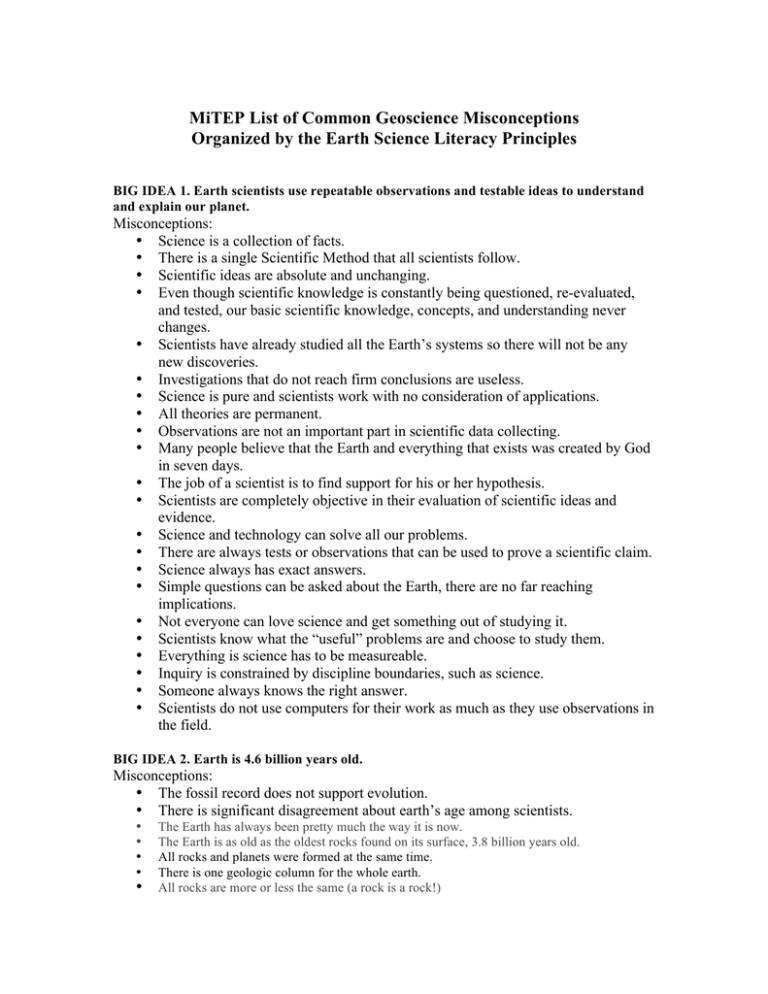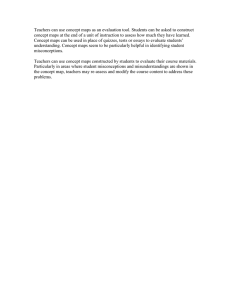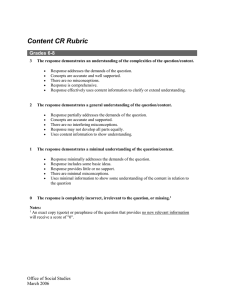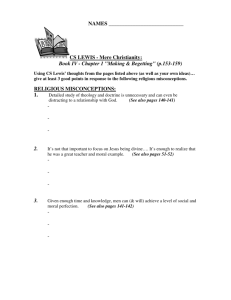Common Geoscience Misconceptions
advertisement

MiTEP List of Common Geoscience Misconceptions Organized by the Earth Science Literacy Principles BIG IDEA 1. Earth scientists use repeatable observations and testable ideas to understand and explain our planet. Misconceptions: • Science is a collection of facts. • There is a single Scientific Method that all scientists follow. • Scientific ideas are absolute and unchanging. • Even though scientific knowledge is constantly being questioned, re-evaluated, and tested, our basic scientific knowledge, concepts, and understanding never changes. • Scientists have already studied all the Earth’s systems so there will not be any new discoveries. • Investigations that do not reach firm conclusions are useless. • Science is pure and scientists work with no consideration of applications. • All theories are permanent. • Observations are not an important part in scientific data collecting. • Many people believe that the Earth and everything that exists was created by God in seven days. • The job of a scientist is to find support for his or her hypothesis. • Scientists are completely objective in their evaluation of scientific ideas and evidence. • Science and technology can solve all our problems. • There are always tests or observations that can be used to prove a scientific claim. • Science always has exact answers. • Simple questions can be asked about the Earth, there are no far reaching implications. • Not everyone can love science and get something out of studying it. • Scientists know what the “useful” problems are and choose to study them. • Everything is science has to be measureable. • Inquiry is constrained by discipline boundaries, such as science. • Someone always knows the right answer. • Scientists do not use computers for their work as much as they use observations in the field. BIG IDEA 2. Earth is 4.6 billion years old. Misconceptions: • The fossil record does not support evolution. • There is significant disagreement about earth’s age among scientists. • • • • • The Earth has always been pretty much the way it is now. The Earth is as old as the oldest rocks found on its surface, 3.8 billion years old. All rocks and planets were formed at the same time. There is one geologic column for the whole earth. All rocks are more or less the same (a rock is a rock!) • • • • • • • • • • • Geologic time can be described using hundreds of years ago. It is easy to understand the amount of geologic time that has passed for changes on the Earth’s surface to occur. All of the Earth’s heat comes from its lingering heat from its formation. Radioactivity is dangerous. Pictures from the Hubble Telescope were made by capturing pure visible light. All uranium ore is highly radioactive. All radioactivity is destructive. The rate of radioactive decay can change. There is a way to define our concept of time. The Earth is younger than 4.6 billion years old. People’s “traditional” sense of time has always existed. BIG IDEA 3. Earth is a complex system of interacting rock, water, air, and life. Misconceptions: • Earth events taking place within the global environment are not interconnected, such as El Nino is not important to people living in the Midwest. • Catastrophic changes on the Earth's surface, like volcanic eruptions and earthquakes, only affect the lithosphere. • The atmosphere, hydrosphere, lithosphere, and biosphere do not cause changes in one another; these systems operate independently on Earth. • The carbon cycle was caused by humans burning fossil fuels. • Increases in global temperatures in the atmosphere and the consequent warming of the oceans, will only create a problem for people living along the coast. • Humans are the only cause of global warming. • All bed-rock is solid, non-porous material. • Earth’s mass never changes. • If you live in an area that is above a confining layer, you cannot get groundwater. • Moving lithospheric plates caused glaciation. • A gravel pit does not have large debris. • Evaporite rocks will be found close to the surface. • The great lakes were always here. • On average, glaciers last less than 1 million years. • When the glaciers came down from Canada, there was only one push and retreat. • A majority of the rocks from a glacier move throughout the places the glacier moves. • Glaciers have nothing to do with the existence of sand pits. • Only gravel and sand are residual effects of glaciers. • We are done with ice age events on Earth. • Glaciers caused gorges to form. • Carbon is only produced by trees. • All clouds are rain clouds. • Clouds over the UP are not due to temperature changes over land and water. • Events that occur on a continent do not effect oceans or the atmosphere. • All beaches create sea breeze. • All shorelines have the same long shore current. BIG IDEA 4. Earth is continuously changing. Misconceptions: The Earth has always been pretty much the way it is now. • Even though most coal found in nature is the altered remains of prehistoric vegetation that originally accumulated in swamps and peat bogs, mankind can make coal so we will never run out. • Rivers do not carve valleys, but only passively flow down them. • Life exists on Earth because the Earth is the right distance from the Sun for water to exist in liquid form. • Separations along bedding plane, like those that dominate most sedimentary outcrops, occur deep beneath the Earth's surface. • Hot spots are just caused by convection currents. • The basalt found in the UP came from violently erupting volcanoes. • Rocks become polarized by the North Pole. • There were never any large mountains in the Keweenau area. • If we don’t see mountains in an area, they never existed there. • The magnetism of the Earth has always been the same. • Conglomerate rock is found near mountains. • The Earth’s North Pole has moved around over time. • The moon rotates once a day. • Radioactive decay depends on the weather. • The Earth is the center of the universe. • The needle of a compass points to True North, not magnetic North. • The sun revolves around the Earth. • A sun dial is for beauty, it’s not really a “time machine”. • Outer space really doesn’t affect Earth. • All rocks are the same. • The sun is directly overhead at 12:00 pm. • Rock layers are always flat. • The last ice age was the only one Earth has ever had. • Snowball Earth was the only ice age. • Glaciers only affected Michigan. • The Great Lakes will always be here unchanged. . ESI I- Big Idea 5 – Earth is a water planet. Misconceptions: • Rain falls when the clouds are too full of water and it drips down. • The atmosphere is made up solely of air. • Air and oxygen are the same thing. • Global warming and the greenhouse effect are the same thing. • The greenhouse effect is bad and will eventually cause all living things to die. • When bottled water is labeled as coming from “pure, still water,” it means it has to come from water that is pure and still. • All rivers in northern hemisphere flow south. • The 'Ice Ages' happened in the past and are now over. • • • • • • • • • • • • • • • The present Ice Caps have always existed on Earth, although their size has changed through time. Water exists in the ground in actual rivers or lakes that are constantly renewed. Groundwater is always found in free-flowing veins and rivers underground. Humans walking about with two bent coat hangers can detect the location of groundwater. Artesian wells operate because they have an elevated aquifer near by the well. Glaciers move backward. The distance from the sun causes the seasons. The toilets in the southern hemisphere flush in the opposite direction than the northern hemisphere. All tides happen in water bodies that are very large (oceans). Tidal activity causes a bulge. Vegetation in an area is the same, regardless of the solar exposure. Lake Superior water has tides because of the moon’s gravitational pull. Lake levels of the Great Lakes have always been the same. Glaciers move backwards. Sand is deposited by wind in dunes. BIG IDEA 6 - Life evolves on a dynamic Earth and continuously modifies Earth. Misconceptions: • Evolution is a theory about the origin of life. • Evolution has never been observed. • The theory of evolution says that life originated, and evolution proceeds, by random chance. • Life on Earth (biosphere) has never caused major changes in the other spheres that make up the Earth System, such as the rocks and air. • Land plants generate most of the oxygen in the atmosphere. • The Earth can absorb and neutralize any amount of waste and pollution over time. • Dilution is still the solution to pollution. • Life on Earth can not modify or cause change in the Earth’s systems. • No one was there to observe evolution so no one knows what happened. • The particles and minerals in soil make up the solid part of trees and plants. • Microorganisms are not important to human survival. • Life on Earth can not modify or cause change in the Earth’s systems. • Earth is too big for us to change, thus the impact of our activities is inconsequential. • Local people cannot improve their environments; it is out of their hands. • Life does not continually change. • Gaps in the fossil record disprove evolution. • Evolution is not science because it is not observable or testable. • Evolution is a theory about the origin of life. • It is easy to find fossils. • Fossils tell us everything about the past. • We know everything that has happened since the beginning of time. • There is no evidence that the Coelophysis (hollow face) was an early dinosaur carnivore. • • • • • Fossils of cyanobacteria do not exist. Fossils are man made. The % of oxygen in the atmosphere fluctuates depending on plant life. Water was not on Earth until the presence of cyanobacteria. We know what happened to the large animals that once roamed the Earth. BIG IDEA 7. Humans depend on Earth for resources. Misconceptions: • People drink bottled water because it is better for our health; the safety of tap water is below consumption standards. • If we run out of oil and gas we will just find more. • Earth's resources are not finite--there is an endless supply of water, petroleum, and mineral resources. All we have to do is to explore for them. • Energy is a fuel. • Green energy leaves no carbon footprint. • We will never run out of natural resources such as coal, oil and other minerals. • "Man-made" materials do not come from mineral resources. • Few products we use everyday have anything to do with taking rocks and minerals from the ground. • Earth is both an endless supply of resources and a limitless sink for the waste products of our society. • Soil is a minor part of an ecosystem, the plants and animals are more important. • All the copper in the UP has already been mined out. • Rocks have very little practical use. • Geologic and social history cannot be found in rocks. • Diamonds, gold, and silver are valuable, therefore, they are not rocks or minerals. • Geologists only work to find materials that people can use. • Copper is a plentiful resource and easy to find. BIG IDEA 8. Natural hazards pose risks to humans. Misconceptions: • Natural disasters happen very rarely and these events are just the bad luck of the people that are affected. • Hazards are random in both time and place and just bad luck. • A 30-year, 100-year, or 500-year flood means that these are set time intervals between flooding events. • Floods are rare, atypical, almost unnatural events rather than normal river behavior. • All natural disasters have only local effects. • Radon is not a big concern. • Flooding only occurs after a heavy rainfall. • Global warming is caused by the hole in the ozone because it lets in more radiation. • The only greenhouse gas emitted by human activities is carbon dioxide from burning fossil fuels. • • • • • • • Radioactivity in rocks is not harmful to people. All rocks have the same amount of radioactivity. A hole in the ozone is not a big problem. The ozone layer doesn’t stop the sun’s UV rays from getting through to the Earth. Volcanic ash from a far away volcano cannot affect Michigan. The lava flows in the UP do not extend out under water in the lake. People are the only cause of an ice age event. BIG IDEA 9. Humans significantly alter the Earth. Misconceptions: • Earth and its systems are too big to be affected by human actions. • If the Earth is too polluted for humans to live on, then we can move to another planet. • The global Earth environment is stable relative to human time scales. • The ozone hole is directly related to global warming. • Human activities cannot affect geological processes like river flow, flood cycles, etc. • Earth and its systems are too big to be affected by humans. • Technological fixes will save us from ruining our planetary environment. • Coal burning is not an environmental problem because humans have invented ways to prevent pollutants from coal burning from entering the atmosphere. • Burning waste to generate electricity does not cause pollution like burning fossil fuels. • Nuclear power is more dangerous than coal power. • Nuclear Waste cannot be taken care of and lasts thousands of years. • It is easy to obtain coal for power plants because coal can be transported to demand centers quickly, safely and cheaply by ship and rail. • Miners just got lucky sometimes, there was no logic involved in where they dug a mine. References: References (AAAS) American Association for the Advancement of Science. (1989). Science for All Americans. Washington, D.C. Black, Alice A. (Jill). ( 2005). Spatial Ability and Earth Science Conceptual Understanding. Journal of Geoscience Education. v53 n4 p402 Center for Science Mathematics and Engineering Education. (1997) Misconceptions as Barriers to Understanding Science (Ch. 4 from Science Teaching Reconsidered). The National Academies Press . Washington, D.C. Dickerson, Daniel, Callahan, Timothy J., Van Sickle, Meta, Hay, Genny. ( 2005). Students' Conceptions of Scale Regarding Groundwater. Journal of Geoscience Education. v53 p374. Dodick, J. and Orion, N. (2003). Cognitive Factors Affecting Student Understanding of Geologic Time. Journal of Research in Science Teaching. 40(4), p415-442 Driver, R. and Easley, J. 1978, “Pupils and Paradigms: A Review of Literature Related to Concept Development in Adolescent Science Students,” Studies in Science Education, 5, 61. Earth Science Literacy Institute (ESLI). (2009). (Earth Science Literacy Principles: The Big Ideas and Supporting Concepts of Earth Science. Retrieved from http://www.earthscienceliteracy.org/ Ebert-May, Diane, Hodder, Jan, Williams, Kathy, Luckie, Doug. (2004). Climate Change: Confronting Student Ideas. Frontiers in Ecology and the Environment. v2 n6 p324-325. Fraser. A., (2000). Bad Meteorology. Retrieved from http://www.ems.psu.edu/~fraser/BadMeteorology.html. Gilbert, J. K. 1977, “The Study of Student Misunderstandings in the Physical Sciences,” Research in Science Education, 7, 165. Gobert, Janice. (2000). A typology of models for plate tectonics: Inferential power and barriers to understanding. International Journal of Science Education. 22(9), 937-977 Henrique, Laura S. Children's misconceptions about weather: A review of the literature. Presentation at National Association of Research in Science Teaching. Retrieved from http://www.csulb.edu/~lhenriqu/NARST2000.htm King, C. (1993). Students, fieldwork, space and time. Teaching Earth Sciences. 18(4), 144-148 King, C. (2000). The Earth's Mantle Is Solid: Teachers' Misconceptions About the Earth and Plate Tectonics. School Science Review; v82 n298 p57-64. Lehmann. K, 2000. Bad Chemistry retrieved from http://faculty.virginia.edu/lehmannlab/badchemistry.html Libarkin, Julie C. (2005). Conceptions, Cognition, and Change: Student Thinking about the Earth. Journal of Geoscience Education, v. 53, n. 4 Libarkin, J. and Kurdziel J. (2001). Research methodologies in science education; assessing students' alternative conceptions. Journal of Geoscience Education. v49(4), p378-382 Lightman, A. and Sadler, P. M. 1993, “Teacher Predictions Versus Actual Student Gains,” The Physics Teacher, 31, 162. Nussbaum, J. (1985), in Children’s Ideas in Science, eds. R. Driver, E. Guesne, and A. Tiberhien, Philadelphia: Open University Press, 170. Orion, N., Hofstein, A., Tamir, P., and Gidding, G.J. (1997). Development and Validation of an Instrument for Assessing the Learning Environment of Outdoor Science Activities. Science Education. 81(2), 161-171. Philips, W. (1991). Earth Science Misconceptions. Science Teacher. v58 n2 p21-23. Phillips, W. (1991) Earth Science Misconceptions retrieved from http://k12s.phast.umass.edu/~nasa/misconceptions.html. Prather, J. P. 1985. Philosophical Examination of the Problem of Unlearning of Incorrect Science Concepts, National Association for Research in Science Teaching ERIC document: ED256570. President and Fellows of Harvard College. 2006. MOSART – Misconception-Oriented Standard Based Assessment Resources for Teachers. Retrieved from http://www.cfa.harvard.edu/smgphp/mosart/index.html Project 2061, 2001, Atlas of Scientific Literacy, Washington: American Association for the Advancement of Science. Plait, P., 2004. Phil Plait's Bad Astronomy: Misconceptions. Retrieved from http://www.badastronomy.com/bad/misc/index.html. Sadler, P. M. 1987, in Second International Seminar on Misconception and Educational Strategies in Science and Mathematics in Ithaca, NY, ed. J. D. Novak, Ithaca: Cornell University Press, 422. Sadler, Philip M., Coyle, Philip M., Miller, Jaimie L., Cook-Smith, Nancy, Dussault, Mary, Gould, Roy R. (2010). The Astronomy and Space Science Concept Inventory: Development and Validation of Assessment Instruments Aligned with the K–12 National Science Standards. Astronomy Education Review. 8, 010111-1. Schoon, K. J. 1988, “Misconceptions in Earth and Space Sciences: A Cross-Age Study,” Ph.D. dissertation, Loyola University. Sneider, C. I. and Ohadi, M. M. 1998, “Unraveling Students’ Misconceptions about the Earth’s Shape And Gravity,” Science Education, 82, 265. Steer, David N., Knight, Catharine C., Owens, Katharine D., McConnell, David A. (2005). Challenging Students Ideas About Earth's Interior Structure Using a Modelbased, Conceptual Change Approach in a Large Class Setting. Journal of Geoscience Education. v53 p415 Trundle, K. C., Atwood, K. R., and Christopher, J. E. 2002, “Preservice Elementary Teachers’ Conceptions of Moon Phases Before and After Instruction,” Journal of Research in Science Teaching, 39, 633. Trundle, K. C., Atwood, K. R., and Christopher, J. E. 2007, “Fourth-Grade Elementary Students’ Conceptions of Standards-Based Lunar Concepts,” International Journal of Science Education, 29, 595. Wandersee, J. H. 1986, “Can the History of Science Help Science Educators Anticipate Students’Misconceptions?” Journal of Research in Science Teaching, 23, 581. Zeilik, M., Schau, C., and Mattern, N. 1998, “Misconceptions and Their Change in University-Level Courses,”The Physics Teacher, 36, 104.



